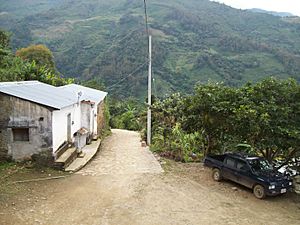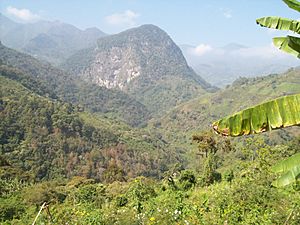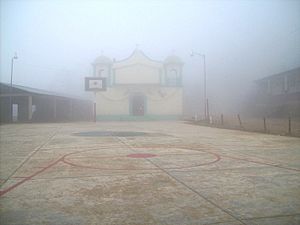San José Chinantequilla facts for kids
Quick facts for kids
San José Chinantequilla
|
||
|---|---|---|
|
Municipality and town
|
||
|
||
| Country | ||
| State | Oaxaca | |
| Population
(2010)
|
||
| • Total | 507 | |
| Time zone | UTC-6 (Central Standard Time) | |
| • Summer (DST) | UTC-5 (Central Daylight Time) | |
San José Chinantequilla is a small community in Oaxaca, a state in Mexico. It is part of the Totontepec Villa de Morelos municipality, located in the Mixe district within the northern mountains. The town was started by people who moved there from Guanajuato in 1913.
In 1920, it became part of the Totontepec Villa de Morelos municipality. It was first called "Chinantequilla." In 1969, its name changed to "San José Chinantequilla." The name comes from the Chinantec words meaning "A bank of Grass." In the Mixe language, it is written M³eviam and means the same thing. The town is about 162 km from Oaxaca City, the state capital.
Contents
What's in a Name?
The name Chinantequilla comes from the Chinantec words. Chinan means "shore" or "edge." Qiya means "grass" in Spanish, which is a common plant here. The ending "te" is a short way of saying tepec, which means "place." So, Chinan-te-quiya means "on the edge of grass."
In Cojum, a version of the mixe language, it is called Käjpen Mëeviam. This name means "At the edge of the hill of grass."
A Look Back: History
We don't know much about how San José Chinantequilla first started. This is true for many Mixe communities because not much was written down about their early days. Researchers think it was one of the last places to be settled in the Mixe region. This is why it's seen as a "young" community.
One idea about the town's beginning is that people from Guanajuato arrived and settled here. At that time, this area belonged to the community of Santiago Amatepec. Their neighbors were the Chinanteco people, who lived in San Juan Comaltepec. For many years, these groups fought over this land.
The fighting ended when Ignacio Franco, a lawyer, arrived. He talked with the leader of Amatepec. He suggested that Amatepec could get the disputed land of Chinantequilla if they helped him with a legal case. After about a year, the court decided in favor of Santiago Amatepec. On May 13, 1913, Ignacio Franco was given a document that officially gave him the land. This land is now known as San José Chinantequilla. The Mixe are known for being strong fighters. They fought against the Zapotec and Mixtec people, and even against the Spanish. Because of this, they are sometimes called "the unconquered."
On June 25, 1920, the government of Oaxaca passed a law. This law made Chinantequilla an official Municipal Agency. It became part of the Totontepec Villa de Morelos municipality.
Where is San José Chinantequilla?
San José Chinantequilla is in the northeast part of Oaxaca. It sits high up in the Sierra Mixe mountains. This area is part of the Sierra Norte Region and the Mixe District. The town belongs to the Totontepec Villa de Morelos municipality.
The town covers about 6.9 square kilometers. This is about 0.9% of the total land in the Mixe District. It is located between 17° 15' and 17° 12' north latitude, and 96° 02' and 96° 09' west longitude. The land here is between 1,000 and 1,300 meters above sea level.
Chinantequilla is in the Sierra Madre de Oaxaca mountain range. It is part of the larger Sierra Madre Oriental system. This means it is built on a hillside. Today, it is easier to get to this area than it used to be.
Mountains and Rivers
San José Chinantequilla is in one of the highest parts of the Sierra Mixe. The land is very rugged, with large mountains that make travel difficult. The most important mountain here is Cerro Cotton. It is about 1,396 meters above sea level. This mountain is important for its history and culture.
During the rainy season, there are many water springs. However, these are not used. The rivers in this area flow into the Rio Papaloapan basin. They also flow into the K 2832 sub-basin.
Weather and Climate
San José Chinantequilla has rich soil and different climates. It can be semi-warm or temperate with humid summers. It gets a lot of rain, between 2,500 and 3,000 millimeters. In this community, which is in the Northern Highlands, the average temperature is between 17 °C and 32 °C.
Nature's Gifts: Natural Resources
Plants and Trees (Flora)
The plants in Chinantequilla are very diverse. This is because the land has many different heights above sea level. In the highest parts, you can find cloud forests. These forests are often covered in mist. There are also secondary forests with pines and oaks. Lower down, you can find trees like bat eagle, strawberry, and sweetgum.
People also grow many plants here. There are beautiful flowers like lilys, gladiolas, hydrangeas, tulips, bougainvilleas, geraniums, and alcatrazes. Many vegetables and fruits are grown too. These include maize (corn), squash, mustard, chard, oranges, bananas, sweet lemons, avocados, and tangerines. Coffee is also grown, usually under the shade of other trees like banana, orange, and cedar.
Animals (Fauna)
The animals in this area are also very diverse. Because some communities protect their forests, there is a lot of wildlife. However, some animals are at risk because their natural homes are being destroyed. Hunting is still allowed for some animals that damage crops.
Here are some of the wild animals you might find in Chinantequilla:
- Squirrels
- Brockets
- Badgers
- Wild pigs
- Turkeys
- Tepescuintles (a type of rodent)
- Armadillos
- Foxes
- Raccoons
- Opossums
- Gophers
- Ocelots (a wild cat)
- Hawks
- Herons
- Snakes like the coral snake
- Parrots
- Panthers (a type of big cat)
How Many People Live Here?
In 2010, a survey called the Census of Population and Housing found that 507 people lived in San José Chinantequilla. Out of these, 254 were men and 253 were women. This means about 51% of the people were male.
Between 2005 and 2010, the population grew by 4.2%. Almost half of the people (46.6%) were under 15 years old. About 91.7% of people over five years old spoke an Indigenous language. In 2010, this was 416 people. Most of them (400) could speak both their Indigenous language and Spanish.
Out of the 416 people who spoke an Indigenous language, 411 spoke Mixe. Four people spoke Zapotec, and one spoke Mixtec. Twelve people did not say what their first language was.
How the Town is Run
San José Chinantequilla is a special agency within the municipality of Totontepec Villa de Morelos. This is one of the 424 municipalities in Oaxaca that use a system called customs and traditions to govern.
This means that the leaders are chosen and the town is run based on the old ways and traditions of the people who live there. They follow their culture instead of the usual political systems used in other parts of the state or country. The town agency has a municipal police officer, an alderman (who helps organize traditional festivals), and a Secretary (who handles documents). All these activities are overseen by Totontepec Villa de Morelos.
What People Do for Work
The main ways people earn money in San José Chinantequilla are through farming and selling what they grow. Most people in the town work in agriculture. They grow crops like corn, beans, and bananas. They also produce fruits and vegetables. Some people even make brandy.
Buildings and Services
Shopping
The town does not have big public markets. People get their supplies from small street markets nearby. They buy goods from small, mixed shops.
Sports
The most popular sport here is basketball. The town has two basketball courts.
Homes
In 2010, a survey found that there were 440 houses in the municipality. Out of these, 382 were lived in.
Culture and Traditions
See also
 In Spanish: Chinantequilla para niños
In Spanish: Chinantequilla para niños







